- Home
- Deceptions
- Solar
- Thermal Audit
- Ventilation
- Sensors
- Governance
- Environment
- Reference
- Contact
- News
Energy Alternatives for Newfoundland
Note to educators: Please freely free to incorporate this material into school science classes. We would be happy to add more material, tutorials, answer student or teacher questions and to highlight/publish student work.
[Return to Policy Summary Page]
There is considerable public distrust and skepticism towards the development of the Muskrat Falls hydroelectric project in Labrador. The current plan is to connect it from Labrador to the island of Newfoundland and on to Nova Scotia. This is a very expensive project estimated to cost 6.2 billion dollars , $7.4 Billion (Oct 2012), $10 Billion (Jan 2013) and therefore it is extremely important to carefully consider all the options. A realistic cost given the rugged terrority, unstable soils and frequent land slides and political pressure to keep the initial estimates low is $10 billion plus interest. This project has the potential to double the provincial debt. The spectre of corruption has also been raised, as well as legal issues regarding water rights, the Nova Scotia Link, the federal loan guarantee and the need for a regulatory review, this PUB presentation, Making the Best User of the Lower Churchill and this PUB supplement.
The following points are discussed below:
- The island of Newfoundland does not currently have a electricity shortage
- Population growth has been negative, so demand is unlikely to grow
- There is approximately 850 MW of undeveloped smaller hydro sites on the Island, which could be added incrementally if ever needed
- Wind power has been neglected, and much more capacity can be added
- When the Cornerbrook paper mill finally shuts down, 129 megawatts of Deer Lake power will be avilable on the grid
- Demand reduction via geothermal heating, pellet stoves, improved building insulation and solar heated homes could significantly reduce the need for the provinces only thermal generating station, and perhaps even allow its decommissioning. This option is far the best because it prepares residents for sustainable living and increases disposable income by slashing home heating bills.
- Generation capacity of the upper churchill project could be increased, with full capacity used for peak loading periods that command higher prices, especially since it has the massive Smallwood Resevior to feed it.
Where the Island's electric demand comes from and how to reduce it
During the winter, the electric power demand on the Avalon Peninsula of the Canadian island of Newfoundland requires supplemental generation from an oil fired thermal generating plant in Holyrood. The Holyrood thermal plant burns a heavy fuel oil with significant sulphur content so there is pressure to replace it by bringing in hydroelectric power from Labrador or converting it to natural gas, fed from a future pipeline from offshore oil fields. Other than the Holyrood plant and approximately 26 diesel generators in remote communities, Newfoundland, with its vast hydro electric resources is in the enviable position of being able to exist entirely on renewable energy.
The fundamental causes of high winter energy demand include:
- Poor thermal envelops on all homes (e.g. not enough insulation in the walls)
- Too many large windows on modern homes, and most windows are not installed properly, sometimes literally just nailed on and taped with "tuck-tape".
- Random orientation of homes (crescents and cul-de-sacs make it difficult to get south facing lots)
- Low penetration of technologies such as heat pumps and biomass stoves
- High winter winds
This is further complicated by limited fuel options. Underground piped natural gas is not available, home fuel oil leaks are a major financial liability (regulations here), large propane tanks can only be placed in certain locations (away from windows and doors), wood pellets for pellet stoves are sometimes in short supply -- meanwhile the cheapest thing to install in new homes by far is the maintenance free 220 volt electric baseboard heater. Therefore it is not surprising that baseboard electric heat is the default choice for new homes.
Electric resistance heating is ideal for a highly insulated home where the small heating demands are dwarfed by the up-front costs and long term maintenance of heat pumps, but in general, it makes no sense to consume a kilowatt hour of electricity to make a kilowatt hour of heat when a heat pump can amplify this by a factor of 3 or 4.
Switching to natural gas, heating oil or propane is not a long term alternative because it is not sustainable. Approximately half of the Hibernia reserves have already been extracted. Fuel prices will continue to rise, and a few generations from now, only the wealthy elite will be able to afford the luxury of squandering liquid fuels. Burning liquid fossil fuels in the future will be like burning brandy or olive oil for heat is today. Instead, liquid fuels will be reserved for important things like running tractors, public transportation, aircraft and chemical production.
There is only one long term solution -- use no more power than can be generated by renewable sources (hydroelectric, trees, solar hot water, solar electric and wind). While billion dollar technical solutions such as Labrador power exist to service the demand at existing consumption levels forever, or temporarily in the case of natural gas, there are far more efficient solutions. A dollar spent on reducing demand goes much further than a dollar spent on generation. Some things, such as orienting a home to face south, or installing a large window on the south side of a home rather than on the north -- cost nothing extra and result in an infinite return on investment.
The following sections take a more detailed look at these problems and explore the potential to slash demand and eliminate the Holyrood plant permanently.
Random Sub Division Layouts
Random street layouts and a social expectation that the side of the home with the most windows be facing the street causes two problems:
- Poor solar passive gains (and large thermal losses to northern exposures)
- Many roofs have poor mounting locations for solar panel installation. Ideally, panels would be mounted onto the roof or become the roof itself in the case of flat panels.
The Google Maps image below shows a modern subdivision in the east end of St. John’s (metro population 196,000) with many curved streets and cul-de-sacs which guarantees that most dwellings do not have a southern oriented front face. There are approximately 100 homes in the satellite image below and about 24 of them are approximately facing south.
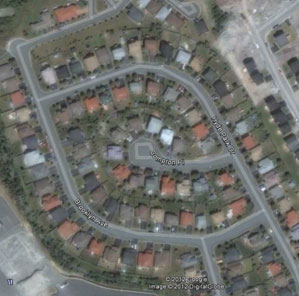
This is essentially random – you would expect about ¼ of the homes to approximately face each of north, south, east and west. If these homes had been rotated to all face south, solar gains would have been higher and heating costs lower. Summer cooling is not required in this climate. To determine the magnitude of these gains, a heat transfer modeling program like the free EnergyPlus product from the US DOE can be used along with a convenient companion product to aid in drawing structures. In this example, a sample home in Design Builder, shown below, was used to feed EnergyPlus.
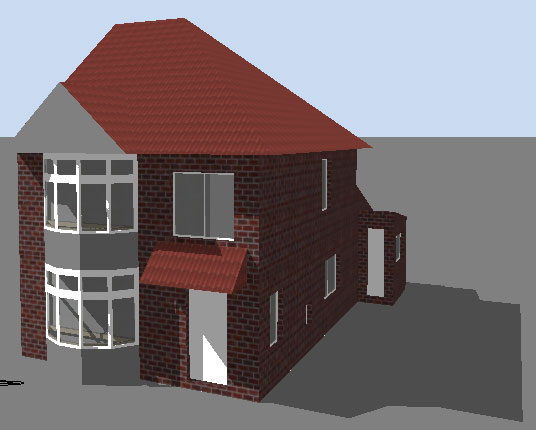
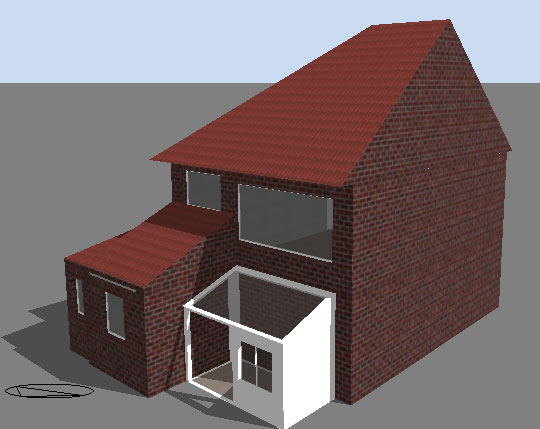
Annual weather data for St. John’s airport was loaded, and a simulation run for January with the above dwelling set for electric heat and Canadian building code standards. The building site was rotated in 90 degree increments and the simulation rerun. The results were as follows:
| Compass Direction | Heat Required | Difference |
0° North |
2349 |
0.00% |
90° East |
2364 |
-0.66% |
180° South |
2477 |
-5.45% |
270° West |
2365 |
-0.69% |
These simulations are complicated – the data is fed into the DOE’s EnergyPlus engine and if you have time to adjust for air leakage, occupancy, whether you leave your computers on all the time, shadows from neighboring homes, soil conditions and hundreds of other factors – you could have excellent agreement with your power bills. This exercise was simply to get an approximation of what happens when you rotate a house through the compass directions without changing anything else.
For this sake of this analysis, it was assumed that three quarters of the homes are not south facing and one of the sides (usually road facing) has the largest windows and is considered the front of the home. The average extra loss for the east, north and west facing orientations for the sample home above is (2.25%). This represents one of the costs of not using street grids. If city planners had insisted on ideal orientations and gone one step further by specifying minimum solar gains, the savings would have been much larger. Solar gains could be massively increased by:
- increasing the south facing window area
- using smaller windows on the northern exposure or by having exterior thermal shutters installed
Roof Orientation
Many homes have inappropriate roof structures for mounting solar panels, either because of the slope, complex shapes or lack of south facing surfaces. This discourages the adoption of PV (the kind that make electricity) panels by substantially increasing installation cost and complexity. Here are some unfortunate mountings that would not be necessary if roof orientation had been a design consideration. The photo of the carwash below is from Gerald at mysolarworld. Check out his web site for some excellent examples of fine craftsmanship in Saskatchewan. The temporary backyard collector has been collecting data in St. John's every 10 minutes for the last three years.
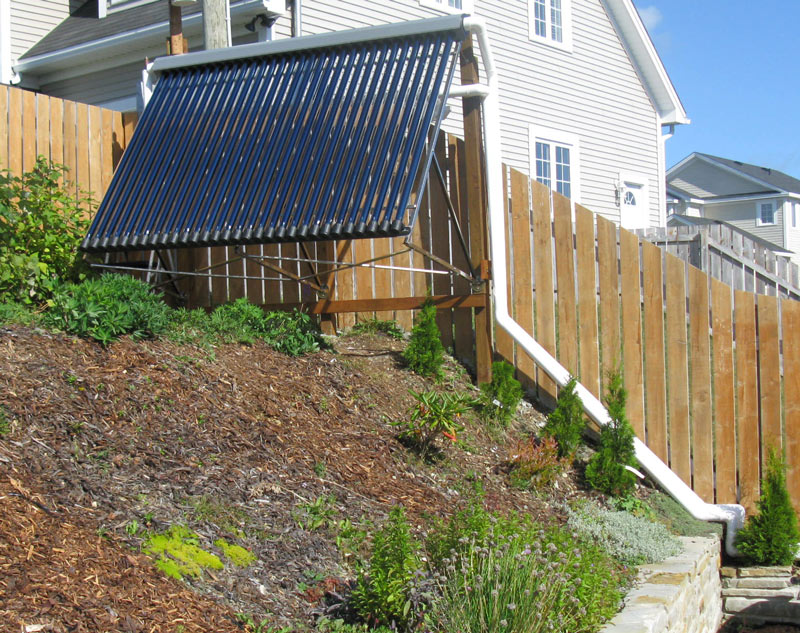
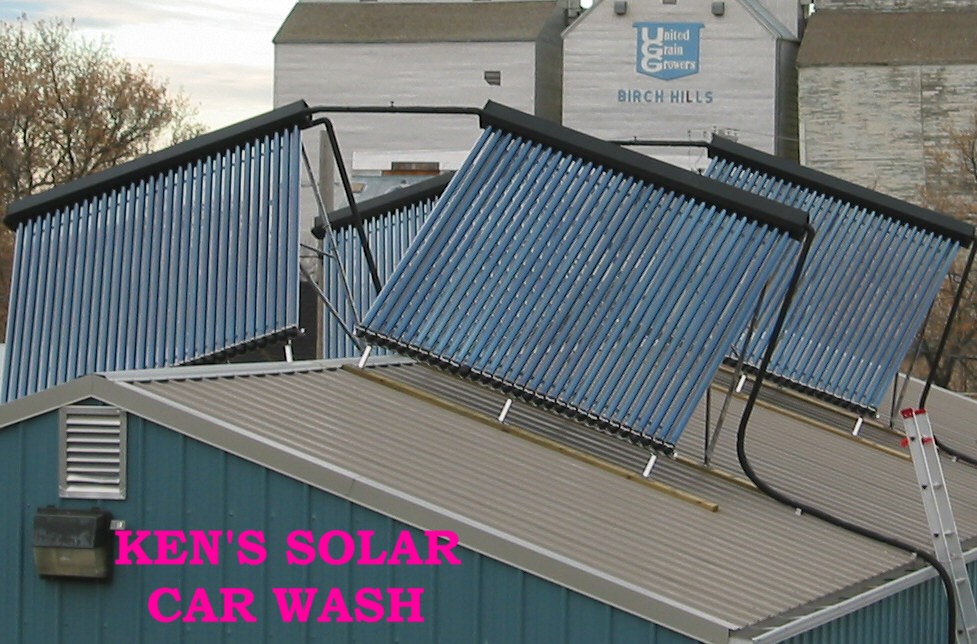
The panels above use vacuum tubes -- they make hot water, not electricity, but the ideal mounting orientation is the same as that for photoelectric panels. Domestic hot water is approximately 1/10 of the home heating demand in Newfoundland (unless you have several teenagers that live in the shower) so these panels are fine for domestic hot water but prohibitive for heating a modern, low efficiency home. Almost all new homes are low efficiency. A 30 tube array can heat 40 gallons of water from 20°C to 46°C on a sunny day and will do absolutely nothing on a cloudy day. This pre heated water would then be fed to a regular hot water boiler to heat it a few more degrees when needed.
Poor Building Envelops
The thermal performance of modern residential structures is not taken seriously enough. While some builders take pride in their R2000 compliant structures, the result is still pathetic. A new 2400 square foot home in St. John’s with 3000 Watts of floor heating can maintain the inside at 21°C above the outdoor temperature with the heater on 24x7. That also means, that at -10°C outside, 3000 watts would keep the home at a chilly 11°C. At current energy rates, 3000 Watts continuous costs $220 a month.
To visualize the problem, consider this image taken with a camera that records temperature. The scale is in Fahrenheit. The vertical wall studs are are cool (blue) and the insulated areas between the studs are warmest (yellow). Ideally, the entire interior would be close to room temperature. The blue area on the ceiling has a cold air leak and should be warm because there is a heated bedroom above.
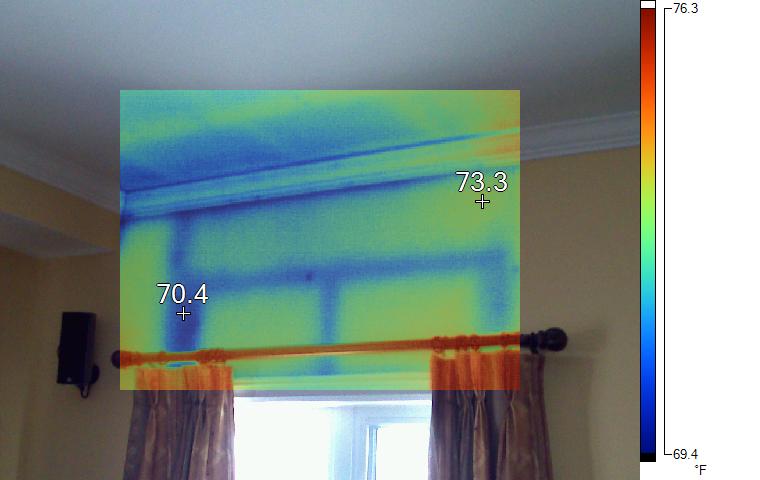
Here is another home on a cold day (20°F) showing warm windows and foundation. Ideally, the outside of the home would be blue and cold.
These problems are solved in solar passive homes by a combination of techniques. One of the simplest to use in Newfoundland is to simply build a double wall, using 2x6 lumber for the outside, and 2x4 studs for the inside wall that supports the drywall. The two walls are separated by about 18 inches or more, depending on how much insulation is desired. Window losses are minimized by adding exterior thermal shutters which close at night and by minimizing or eliminating north facing windows. It is also feasible to eliminate all non-south windows and pipe in light from solar optical panels via fiber optics for day lighting. The biggest obstacle for adoption is coming up with designs that are appealing and inexpensive to build, and then get building codes modified to allow their construction.
If you are a community planner, consider building a community center with solar passive techniques so that your annual operating costs are minimal and let it double as a demonstration/education project to drive changes in building code.
Geothermal Heat Pumps
Geothermal heat pumps are four to five times (75% to 80%) more efficient than electric baseboard heating. For more details, visit Geothermal Heating in Newfoundland.
The electric heating demand in winter is approximately 500 megawatts (a crude estimate based on the fact that the Holyrood plant is idle in August for maintenance and at full winter capacity in the coldest weather). Since this is primarily due to heating demand, heat pumps would divide this by four resulting in a reduction of 375 megawatts.
Electric Demand
The following charts are from the Nalcor report Generation Planning Issues July 2010 Update. The forecast is for continuous, fairly smooth growth in electricity demand -- something that is rather unlikely given the current state of the worlds economy and the lack of quality local employment, especially for apprentices. The Newfoundland population is declining as well as the school population. As fossil fuel prices go up and families spend more of their disposable income on gasoline, they are likely to turn down the thermostat rather than risk their power being disconnected. However, assuming Nalcor's assumptions are accurate, the goal should be to eliminate demand growth so that the existing renewable power sources remain adequate.
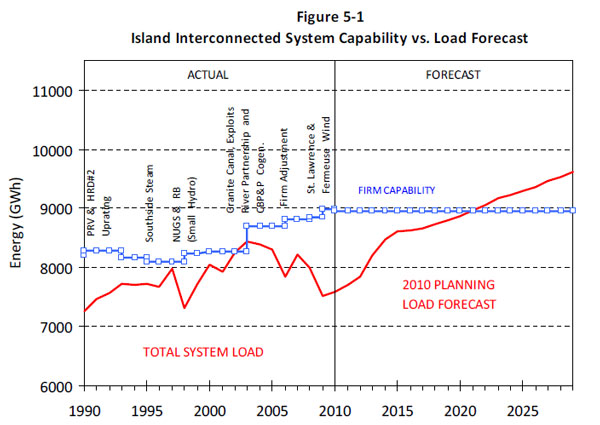
The next diagram shows the high voltage link (HVDC) followed a few years later by the elimination of the Holyrood thermal plant. The billions of dollars spent on this link will be passed on to tax payers -- and if Newfoundlanders decide to be resourceful and reduce demand by going geothermal and moving towards solar passive designs in new home construction -- the huge cost of building the unneeded infrastructure will result in large rate increases or government cutbacks in other areas. This power would be better staying in Labrador and converted into high energy products for export by rail and ship.
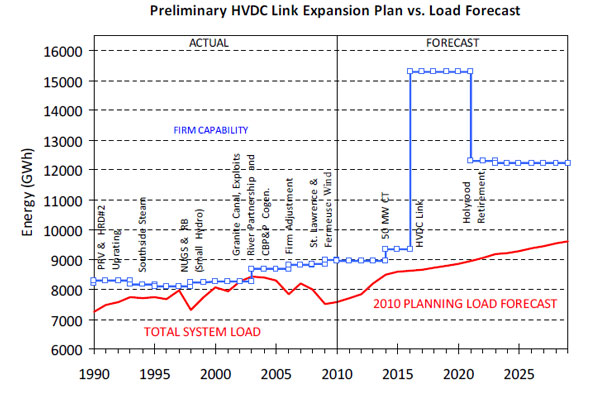
From the Statistics Canada community profiles page, the total number of occupied residential units is approximately 197,000. Also note the population declined from 2001 to 2006 -- this doesn't inspire confidence in the future growing electric demand hypothesis. Trends like this "EI study asked recipients to consider moving" wont help increase the population either.
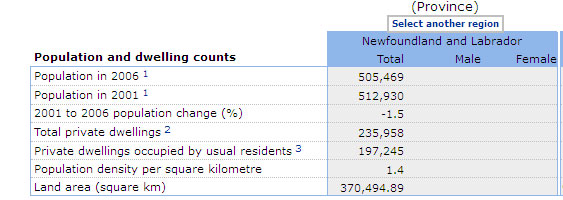
What would happen if the government was to purchase heat pumps and set up a budget plan for repayment? Perhaps the heat pump units could be manufactured locally by a worker owned engineering co-op so that much of the the manufacturing labor stayed in the province, and be designed to be repairable in-province , and ideally, on-site (no planned obsolescence).
Load shedding is another option, and has been moved to its own page.
Demographics
The population issue warrants further analysis since a decline in population will reduce electric demand, and therefore, Labrador power will never be needed in the Island. Increasing power demand is one of the current justifications for bringing power from Labrador to the Island. Consider the following from the NL Government presentation "Demographic Change - Issues and Implications":
"Currently the province’s fertility rate is approximately 1.3 children per childbearing age woman, the lowest in the Country and well below the 2.1 rate required to just maintain current population levels in the absence of out-migration." Notice -- in the absence of out-migration.
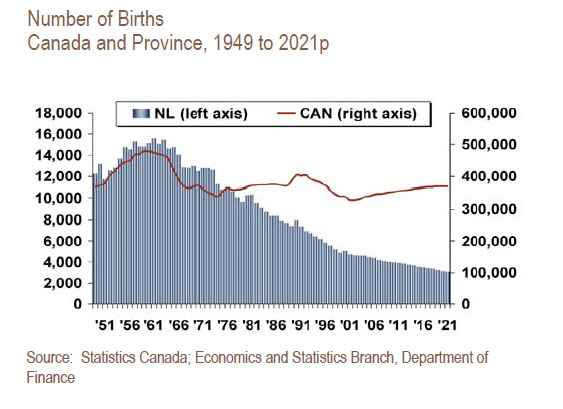
"The number of births have declined continuously since the baby boom ended in the mid-1960s. Births dropped from over 12,700 in 1971 to about 4,400 in 2006, and are projected to drop to less than 3,100 by 2021. This trend is the result of a complex set of economic, social and cultural factors that are not easily changed by policy interventions."
This is not all bad though, because the Island is already beyond its carrying capacity (200,000 is a crude estimate based on using every hectare of arable land to grow potatoes plus reverting to family homesteads). The message here is this: read the report linked above then look at the graph below and ask yourself -- why is Nalcor promoting the idea that electric load is going to increase in linear fashion onward to 2030 ?

Nalcor's Leadership Blog suggests that this is partly due to new household creation and that the over 25 age group is moving into new homes. This can only be a temporary phenomenon in a shrinking population -- eventually those parents pass away and some of the children set up home on the mainland. A more likely scenario is that people are abandoning rural Newfoundland and moving to St. John's where almost all new homes have electric heat. Additionally, due to changes in oil tank regulations (e.g. no refills for old tanks), many have switched from heating oil to electricity. Another trend is towards very large homes. There is a simple solution for such waste: Implement a two tiered rate system - 10 cents/kWh for enough energy to heat a modest 3 bedroom home, and 20 cents/kWh for the excess. Those purchasing $600,000+ homes can either pay for their wanton waste, or purchase a heat pump. The Nalcor blog entry linked above states "The strong preference for electric heat across both residential and commercial customers will also continue to be a primary driver of load growth on the island with an expected 86 per cent of new homes installing electric heat.". This is a sad commentary -- note further down this article that about 70% of Norwegian buildings used electric heat, but their government took steps to reduce demand. True leadership would be Nalcor supporting demand reduction -- not increasing the capacity for waste.
Drain Water Heat Recovery
There are many energy saving technologies that cost very little if they are planned for, but become acts of home demolition otherwise. Drain water heat recovery using a simple counter current heat exchanger is a good example. Counter current means that the waste water moves from top to bottom while the fresh water in the outer coil moves in the opposite direction. This is how penguins keep from losing heat through their feet.

The photo above shows a 4 inch copper sewer pipe that has a copper tube coiled around it. Cold city water enters at the bottom of the coil, and exits from top. When a shower is on, hot water swirls down the 4" copper pipe, sticking to the sides which then heats the incoming tap water. This can recover approximately 50% of shower heating costs.
Simple? It should be but often is a nightmare. It is now common to have several sewer stacks, so it is possible that that each shower is on a different stack. Using two heat recovery units not only doubles the equipment cost, but each unit drops the water pressure - so it only makes sense if all the showers share a single drain water heat recovery unit. There are no gains from baths because you aren't consuming hot water while simultaneously sending it down the drain -- so this is really a shower thing. If everyone in the household takes daily showers it will pay off in about three years.
A long, uninterrupted section of vertical sewer drain is required because the longer the heat exchanger, the more efficient it is. It is also desirable to have six inches of uninterrupted sewer pipe above the heat exchanger so that the waste water has a chance to become less turbulent and begin sticking to the walls of the pipe. Unfortunately, many new homes have 2 inch drain lines entering the stack at 45 degrees, intersecting it halfway between the floor and the ceiling. This means you have to cut off the smaller waste lines and reinstall them with the standard, more gentle slope, so that they meet the main stack closer to the ceiling. This frees up an unobstructed section in which to insert the heat exchanger. The connection between the drain pipe (PVC or ABS plastic in new homes) and the copper pipe is made with a neoprene coupling surrounded by a stainless steel jacket.
Building code should be changed to require:
-
Showers should share a common stack when physically possible
- There should be a straight section of sewer line that can accommodate inserting a drain water heat recovery unit. Ideally this would be 60 inches or greater.
Discussion
There are two major components to living within our electrical energy means. First is to not use the energy in the first place. This can be achieved with efficient building design and town planning. It is possible to build homes that do not require heating during the winter to be inhabitable. The second component is to use electric power efficiently. Electric baseboard requires 4 to 5 times more energy than geothermal. The combination of replacing electric heat with geothermal and ensuring that all new construction was efficient, would eliminate the need for power generation in Holyrood and leave Newfoundland running on 100% renewable hydro power.
The ultimate low energy shelter is a natural cave, and moving up a step, earthen huts. The Viking settlement in L'Anse aux Meadows is a good example (image source: Wikipedia).
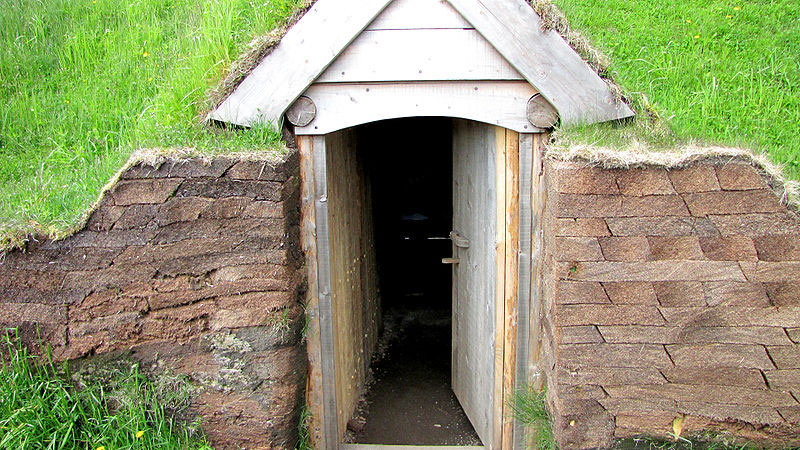
While it is probable that a few hundred years from now we will be back to something akin to the dark or middle ages, there is no rush. Moving into a root cellar wouldn't be much fun. We have the luxury of modern engineering and medical knowledge to create something that is insect and mold free, bright and warm.
An ideal sustainable family home for the Newfoundland climate is one that attempts to be solar passive, meaning that it is heated by the sun and body heat. Unfortunately, 10 day stretches of semi-darkness under heavy cloud cover are common in winter so a solar passive home would be chilly in February. However it would also be very inexpensive to warm up with a small supplemental heat source. In the case of a cash crunch, residents would at least have the option of wearing sweaters, adapting to 15°C room temperatures and being far more comfortable then their great grandparents ever were -- ask your grandparents about running the kitchen sink to keep the pipes from freezing and how cold their homes were at night once the kitchen oil stove was turned off.
There doesn't have to be anything radical about solar passive homes. The most important features would be thicker walls, no windows on the north face, lots of glass on the southern exposure and some heavy interior features like cement floors or a large stone fireplace to moderate the temperature swings. The document "Passive Solar Homes: Case Studies" from the International Energy Agency had a few good examples from Norway. The Vikings of L'Anse aux Meadows would have been proud.
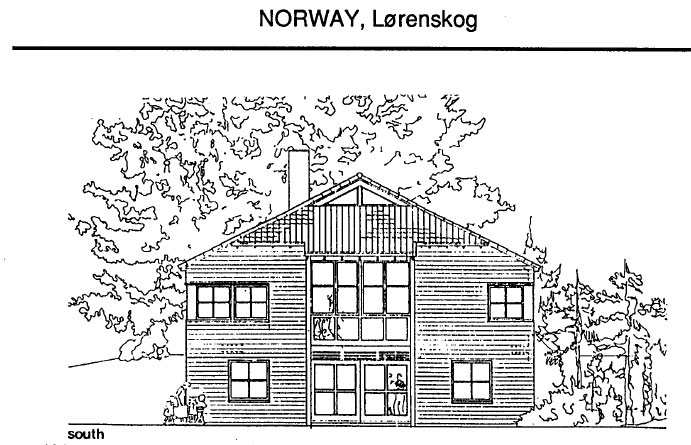
Beyond this, there are all sorts of creative materials and techniques that can create wonderful homes -- but to support that, building codes must be liberalized. Even clotheslines are banned by restrictive covenants in some subdivisions, presumably due to snobbery, so there is a long way to go. To encourage the use of solar electricity and hot water panels, all new construction should have a southern facing roof designed with flat plate or solar PV panel mounting in mind. There are also many competing energy rating programs such as LEED and Green Globes. It would be a mistake to get tangled up with rating methods and certification standards and far better to allow Newfoundland residents the freedom to design lower energy homes (cheap to heat) and ensure that non-standard homes can get building permits. One of the best ways to get this started is for professors at memorial, local architects and builders collaborate to construct some sample low energy homes and make the plans available free of charge. The construction process should be documented and posted on social media sites. These sample dwellings could be built to satisfy the demand for affordable housing. Until people realize that it is possible to build homes with negligible power bills for approximately the same price (or less if you make them smaller with high efficiency layouts as you see in condominiums) as regular construction -- and can walk through model homes to see how nice they can be -- there will be no demand for change. Just as nobody in their right mind would purchase a new economy car that got 12 miles per gallon, nobody in their right mind should want a new home that costs $400+ a month to heat in winter and live in dread future rate increases.
A serious push towards solar passive homes would kill future demand increases for home heating and increase the disposable income of residents. This however does little for the existing problem -- that our existing infrastructure (homes, roads, etc) were carelessly implemented with absolutely zero regard for sustainability. Despite this, electric heating demand can be cut by 75% or more by eliminating baseboard heat and switching to geothermal. Adding exterior thermal shutters and drain water heat recovery could save even more.
Solar active homes, built with solar passive techniques but supplemented with pumps and large hotwater storage tanks have been built in Alaska and can provide heat during months of total darkness.
Newfoundland is not unique; Norway has similar problems. This article, Norwegian households’ perception of wood pellet stove compared to air-to-air heat pump and electric heating states, "Norwegian public investment in the construction of hydropower plants between 1960 and 1990 provided a large capacity of cheap electricity and consequently led to an increased dependency on electricity for heating. Approximately 70% of Norwegian households use electricity as the main heating source, especially in the residential sector" and this "In 2003, Enova, established in 2001 as a public enterprise owned by the OED (Ministry of Petroleum and Energy), ran a subsidy scheme that provided for up to 20% of the total investment costs for all types of heat pumps and wood pellet heating solutions.The number of installations of air-to-air heat pumps more than doubled between 2002 and 2003. This boost was mainly caused by subsidies accompanied by an increase in the price of electricity"
Implementing a 20% heat pump and pellet stove rebate scheme in Newfoundland would probably have a similar effect since both countries have similar electricity rates (1.00 NOK = 0.17 CAD). It is important to note however that it would be far better to eliminate the need for heating energy by moving towards solar passive homes. Lumber and furniture is a far better use of trees than burning them and manufacturing finished goods with hydro power is a far better use than wasting it on baseboard heaters. Renewable energy should be used to create things of enduring value when possible, and not degraded as heat.
Hydroelectric resources and natural gas should be developed when environmentally acceptable
It is wise to develop additional hydro electric resources and bring in natural gas from offshore rather than re-inject it deep underground, but not in a way that is a burden to tax payers or which increases utility costs. Since the monies to build mega projects are borrowed, it is worth considering the insanity of compound interest.
The environmental costs should also be carefully weighted, especially when there is no real need for the power other than to support a profit making venture. The additional generating capacity should NOT be exported. Newfoundland does not need to be grid tied to the mainland. Instead, local energy should be converted into embodied energy -- such as finished aluminum or cement products. Labrador power should stay in Labrador. It is not in the interest of Newfoundlanders to export raw power, raw logs, ore, or unprocessed fish for the benefit of others. Newfoundland and Labrador isn't a colony anymore.
Converting the energy here into high value products would create thousands of permanent jobs. Cheap energy will be in short supply in most parts of the world so even with above average wages, the exported high-energy products will be competitively priced. Iceland is seriously exploring this -- generating power and converting it to high energy products like compressed hydrogen gas for export. Most of the reason for the large industrial base in southern Ontario was due to the Niagara Falls power plant -- i.e. heavy industry located near the power source.
When the cheap fossil fuels are long gone, regions like Newfoundland, Labrador and Quebec with their vast hydro resources, could be centers of great economic power and wealth - provided they haven't sold out and been enslaved with crushing debt from cost over runs and short sighted contracts.
Compare this with the US perspective in diplomatic cables and notice that Newfoundland is seen as simply a raw resource to feed either Ontario or New England.
"23. (SBU) NEWFOUNDLAND AND LABRADOR (7.3 percent of generation) has most of its generating capacity at a remote location in Churchill Falls, Labrador, from which power is exported to the Quebec grid and into the northeastern United States. While large developments are contemplated for new sites on the Lower Churchill River, transmission depends on inter provincial arrangements with Quebec. If Quebec continues to invest in interprovincial ties with Ontario, the majority of new generation from Labrador could end up in the Ontario market. A more expensive export alternative for Newfoundland/Labrador would involve building transmission lines and undersea cables across the Island of Newfoundland and Cabot Strait to Nova Scotia and thence to New England, an ambitious (and early-stage) idea which Nova Scotia and Newfoundland have agreed to consider. "
or this:
"SUMMARY: Suitors have lined up for a chance to be part of the long-anticipated project to develop the hydroelectric resource of the Lower Churchill River in Newfoundland-Labrador. A tough but calculated business plan by Premier Danny Williams, coupled with new market dynamics, has economists and even the Premier's staunchest political foes predicting that it looks good for the multi-billion dollar project to proceed. Estimated output from the facility could be enough to supply 1.4 million households in eastern North America. However, until the provincial government decides on a specific marketing and transmission plan, just what portion of the output will be available for export to the United States will remain unknown. "
The US is clearly interested in Atlantic Canada's power production -- click here for an interesting overview from the United States consulate in Halifax, Nova Scotia. Someone stands to make a lot of money of the province's natural resources. First Britain, then Quebec, and next time, it will probably be a consortium of large corporations and banking interests.
Feed in Tariffs
A feed in tariff is a rate structure where you can sell power from your roof mounted panels, wind turbine or micro-hydro plant to the electric grid (i.e. the network of power lines and poles). There is a fundamental problem though -- since electric power can be generated for a few cents per kWh from hydroelectric dams -- why would a power company want to pay ten times more to buy it from homeowners? They don't of course, nor do they currently have the meters in place on homes to support the billing. In order to entice home owners to install panels and turbines, the purchasing rate needs to be very large -- enough to pay off the solar panels, electronics and installation costs in several years.
For example, the Ontario microFIT program used to offer 80.2 cents a kWh for home rooftop generated solar power, whereas you normally pay 10 cents a kWh and a power company can generate it for a few cents. This makes the solar installation profitable for the home owner and results in the installation of large quantities of renewable energy capacity on roof tops. The costs are shared by all -- for example, if half the province's power was generated by roof top solar at 80 cents rather than 3 cents from a hydro dam, then the basic electric rates for everyone would have to go up significantly. Paul Gipe's Wind-Works.org site has an excellent review of tariff programs and rates.
In parts of the world that rely on fossil fuels, this makes sense. Everyone's rate goes up and everyone helps finance the build-out of billions of dollars of solar PV and wind turbines. When the fossil fuels get too expensive there is no disaster looming, just increase the tariffs a little more and renewables will take over entirely.
What then happens in a place like Newfoundland and Labrador where there is an isolated grid and most of the power (and almost 100% of it in the Summer) is already renewable? (see National Energy Board)
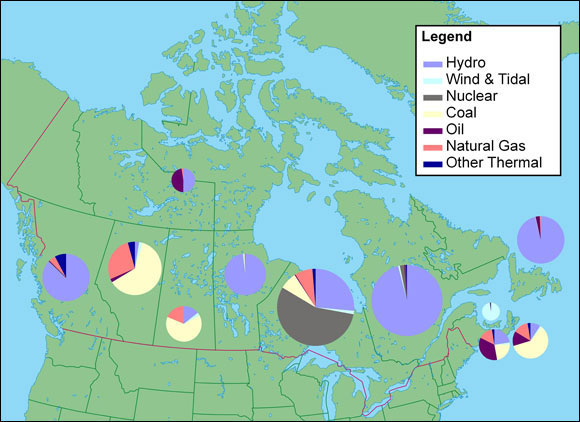
And not just renewable, but high quality hydro electric power generation plants with excellent water reserves. You would be in effect, replacing the ideal renewable source -- with higher cost renewables, just because. As a thought experiment, imagine a tariff of $1/kWh and that residents went 100% wind and PV because everyone wanted to get a check from the power company every month. This of course is impractical because of storage problems (batteries to store daytime solar energy for use at night), but would result in everyone paying several times more for any power they drew from the grid and the hydro plants would be idle. Feed in tariffs are handicaps to allow expensive technologies to wipe out older, dirtier and cheaper technologies. Newfoundland only has one dirty project - the Holyrood power plant used for winter demand. Dependence on this old dirty plant, and reducing greenhouse gas and air pollution, is most inexpensively handled by slashing winter heating loads.
If you live in one of the unfortunate provinces with very little hydro power (see map above), then you absolutely should have feed-in tariffs so that you get a head start on building out alternative infrastructure while you can still afford it.
Recommendations
There is no need for Labrador power from Muskrat Falls to be brought to the island, and even if the island needed power, the island's undeveloped small hydro resources are the same size as Muskrat Falls. The Holyrood plant can be left in operation as a synchronous condenser and emergency backup facility.
- All new homes and commercial buildings should be built to vastly improved thermal standards.
- Electric resistance heating should be banned in new commercial construction.
- There is 850 MW untapped small hydro resources on the island. These should be developed to phase out the oil fired generation facilities in conjunction with demand reduction.
- Residential electric heaters should be fed to an electrical sub-panel outfitted with a load shedding relay.
- Sub divisions should be laid out in grids so that all homes can have a southern exposure.
- All new homes should have a roof structure and orientation that can support solar collectors.
- All new homes should be set up for drain water heat recovery for the showers.
- Financial assistance / rebates should be offered to home owners for geothermal and wood pellet heating systems.
- Model solar passive homes should be built now with government support (research and funding) and builders should be able to freely copy them.
- The Holyrood plant could remain as a synchronous condenser and rarely used backup.
- Adding generation capacity via natural gas (new gas turbines) and building new labrador hydroelectric projects but NOT connecting it the rest of Canada could be considered a public survival strategy. Using power for energy intensive industries and exporting the wealth as embodied energy would serve as a long term replacement for provincial cash flow since the offshore oil and gas are in decline and the province has no real control over the marine fishery. The cost of the new electric capacity should be billed to this new industry -- not residents who can live off today's renewable capacity. All this has to make business sense -- it cannot be justified by the unlikely idea that the Island will have a shortage of electrical power in the future.
- Feed-in tariffs should be implemented since they encourage residents to explore self sufficiency, reduce load on the grid and add redundancy. A small rate increase to support these tariffs (less than 10%) would also encourage conservation. However, unlike Ontario that needs to consider replacing the nuclear plants someday, the Newfoundland feed-in tariff program could be limited to small scale, home sized projects since it is wasteful to build a huge overcapacity.
- The regulations for the distribution of crown land should be modified to allow homestead sized lots (80 acres) to be leased so that residents that want or need to fend for themselves and their families can. The current lots sizes for cabins and standard building lots are far too small for any form of self-sufficiency. The standard throughout Canada and the USA for homesteads used to be 160 acres.
Research Needed
The following would be excellent research topics for faculty and students at Memorial, provided they could get sufficient funding. Unfortunately, most funding is directed towards industry and special topics like arctic or offshore marine issues. Nothing on this site is funded with grants.
- Determine the ideal diameter, depth and spacing of geothermal wells for the various geological regions of the province. Since water will be returned to the aquifer, it is important that the system be designed to prevent contamination and well clogging. Options for well sharing between neighbors and city blocks should be analyzed. Should geothermal and drinking wells be shared? Outputs should include recommendations and data to support changes to building code. The modeling software to determine this is well understood by many civil engineers.
- Fiberglass and polystyrene insulation is expensive, yet there are old homes downtown St. John's that have sawdust filled walls which work well. Double wall solar passive homes need a great deal of filler. A sample wall needs to be built using processed sawdust (local tree species) and evaluated for insect resistance (earwigs, ants), permeability, fire resistance and insulation value. Can the permeability be adjusted to eliminate the use of vapor barrier and mechanical ventilation?
- Build a prototype solar passive home specifically designed for Newfoundland climate and lifestyle. Test it extensively with thermal imaging. Once perfected, the plans and construction details would be provided free for owner/builders and perhaps for a small fee to tract builders. Proceeds will support graduate student research projects and senior undergraduate design projects. A local architect could give it some curb appeal and it would make an excellent dream home to raise public awareness.
- Design a smokeless wood pellet stove (or almost smokeless) that can be used within city limits as a water boiler for space heating. This is a good project for some mathematical modeling of combustion chambers, and perhaps it could be cast from lightweight ceramic.
- Design a smokeless trash incinerator. Waste could be converted into water heating, produce an alkaline ash for augmenting the acidic soil and would absolutely minimize landfill usage. On a larger scale, trash incineration can be used to power a generator. If you credit these with the landfill costs of the waste burned, the electricity produced can be free. The many issue is controlling combusting to minimize air pollution.
- Determine the maximum sustainable population of the province -- assuming that residents must live on local resources, including food calories, heating fuel and water. Intelligent long term planning is impossible without knowing this. This task should be given to every university in Canada, which each institution coming up with a report for their province. Conflicting reports could then debated.
These are not the kind of activities that large corporations are interested in supporting because it does nothing to increase consumer demand nor corporate profit nor protect shareholder investments in existing infrastructure. Corning won't be funding experiments to replace fiberglass with local wood fiber anytime soon. Some governments don't like inconvenient scientific findings either.
Note: Last update July 29, 2013. Please use the comment form to request anything you want clarified or expanded upon.
